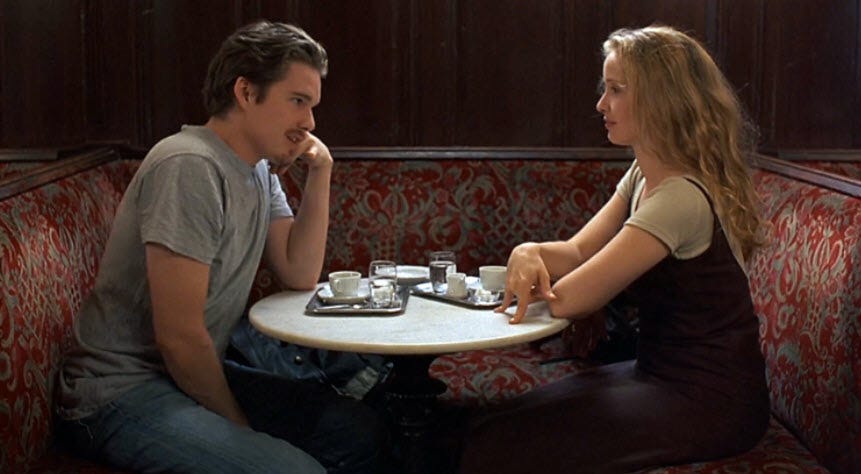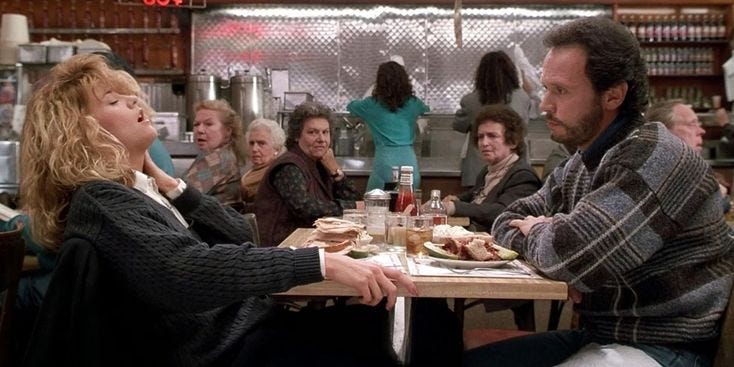“Jade’s Definitive Guide to Living Life” is a new The Strawberry Gazette series where I explain my original, highly-specific theories about how best to live (not just survive, but thrive!) in a niche facet of life. Today’s edition is on seating arrangements in dinner booths. As always, subscribe for more!
I was watching Fargo (1996) with Cait at the PCC the other day when in the middle of the gristly murder-crime plot came a scene of sudden and abject racism, which is sort of besides the point of this article but I still wanted to point out. It’s like watching Breakfast at Tiffany’s (1961), and in the middle of Audrey Hepburn running about New York in full glamour you have a random yellowface caricature of an Asian man with a heavy accent, which is, sure, a relic of its time, but just unnecessary and Bruh-inducing.
In Fargo, the detective, Marge Gunderson, catches up with her highschool classmate, Mike Yanagita, who tries to romance her despite the fact that she’s visibly pregnant. For a quick rundown of why this is racist (again, not the point of this article), there’s something beaten-to-death to be said about how the only Asian character in this movie is made to be this pathetic, stammering (and as we find out later, lying) creep pervert , playing into Hollywood’s revolting pattern of emasculating Asian men. Also, the character is Japanese, but the actor is Korean. This would not be an issue if it weren’t for the fact that he speaks in an American accent, except for his exclamations where he uses this exaggerated Japanese accent. Of course it’s racist, but what’s even more offensive to me is that it’s really unfunny. For an example, he pronounces the English word “so” in the Japanese way “sou (そう)”, even though that means something completely different, and so would hardly be realistic, and just comes off off-putting. But this is a complete digression.
When Marge and Mike first meet, we see them sitting across from each other at restaurant booth. Mike is a wrecking ball of awkwardness that comes off as superficial, disingenuous and desperate as they catch up on their employment, marital status, and so on and so forth.
At some point, he gets up from his seat, moves over, and attempts to sit next to her at the booth while putting his arm around her.
Decisively, Marge tells him to move back.
After he moves back to his seat across from her and apologises, she replies, “Oh no, no, just so I can see you, don’t have to turn my neck.”
Later, Margo finds out that not only did Mike lie about his job, he also lied about his wife dying, as well as, well, the wife’s existence as a whole (in reality the target of his stalking for years). Compared to the gun violence and sex and sociopathy in the rest of the film, this scene seems innocuous and out of place. But it is the catalyst for Margo realising that people, in fact, do lie through their teeth, and unravels the rest of the mystery for her (this isn’t a spoiler).
The Dinner Booth Theory
My theory is as follows: it is a red flag for a date to consistently want to sit next to you instead of across from you, especially if you are just getting to know each other (first few months of dating). This is not gendered. My caveat here is that this is for very specific settings, like a coffee date, but in particular a restaurant date, where you’re supposed to be both talking and eating. This applies in particular to four-seater tables in this arrangement, where you have the choice to sit either across from the person or beside the person, or a dinner booth like in Fargo. This does not apply if there are more people than the two of you (if it’s a double date or a group outing or something).
Of course, if you’re at a picnic, or if you’re at home eating while watching a show together, or if you’re even on the bus, or if there’s some special reason you need to sit next to each other (maybe the type of food), this does not apply. The preference to sit side-by-side must be pure and not tainted by external factors like convenience.
The reason why this is a red flag is simple: as Marge puts it, the purpose of sitting across someone is so I can see you, and I don’t have to turn my neck. When you are just getting to know each other, what you need to do is first and foremost communication. What you should be interested in is understanding the other person and knowing more about them because you don’t know them very well. This isn’t just about listening to their voice — it’s about seeing their facial expressions as well, which you simply cannot do very well when you are sitting next to them. Sure, you can turn to face them if there isn’t food, but once you’re eating you’re going to have to start twisting back and forth, which is just suboptimal for talking or getting to know someone. The act of actively and consistently choosing to sit next to someone, in these settings, then, shows a prioritisation of the physical presence of the person, and an unconscious ranking of physical closeness over emotional closeness.
Moreover, there’s something here to be said about possession. When you’re sitting across from someone, your relationship has plausible deniability. You could be colleagues, you could be friends with benefits, you could be friends without benefits, you could be siblings, you could even be a stalker-and-stalkee. But when you’re sitting next to someone, the plausible deniability goes down real fast. Part of this makes me feel like the strong preference of sitting next to someone in these hyper-public settings is a symbol of a desire to possess, like a toned down version of the practice of leaving visible hickeys on a partner.
I’m not saying that side-seaters are automatically ontologically (which is a word I use btw) evil and undeserving of love! All I’m saying is that when you’re just getting to know (point is prematurity) someone in a romantic capacity and they consistently prefer this seating arrangement, something may be slightly amiss. Do they want the perception of a partner, any partner, or do they want you in particular? Do they want to get to know you, truly, genuinely, or do you they want to get to be with you based on some preconceived notion of who they think you are? At the end of the day, the Dinner Booth Theory is a mere metaphor for something bigger, and a prodding reminder of something that you can only assess by yourself.
Recently, I had a 40-minute call with one of my best friends Zachary and his long-term girlfriend, Sherry, over in sunny Australia. As a side-seat fanatic, Zachary wants me to highlight with utmost clarity here that side-seating is all fine and dandy if you’re in an established relationship. I agree! Against all allegations, I am not a puritan. In a relationship, you (ideally) already have a deep understanding of each other, and spend most of your time in conversation. It’s absurd, then, to insinuate that a desire for physical closeness with your partner (or even a tinge of public possessiveness) is some sort of strange pervert behaviour. It’s normal and natural and in fact probably really good for your relationship to feel this way. Just not on the first few dates.
A couple of days later, Sherry and Zachary sent me this bubble:
Zachary’s solution is perfectly acceptable to me! There’s no neck-turning, you’re close to each other but not too much, and you can eat your food in peace (see where my priorities lie). Plus, if the vibe is right, you get the chance to have some strategic knee-touching. #BestofBothWorlds
Romance isn’t dead. It’s just diagonal.














